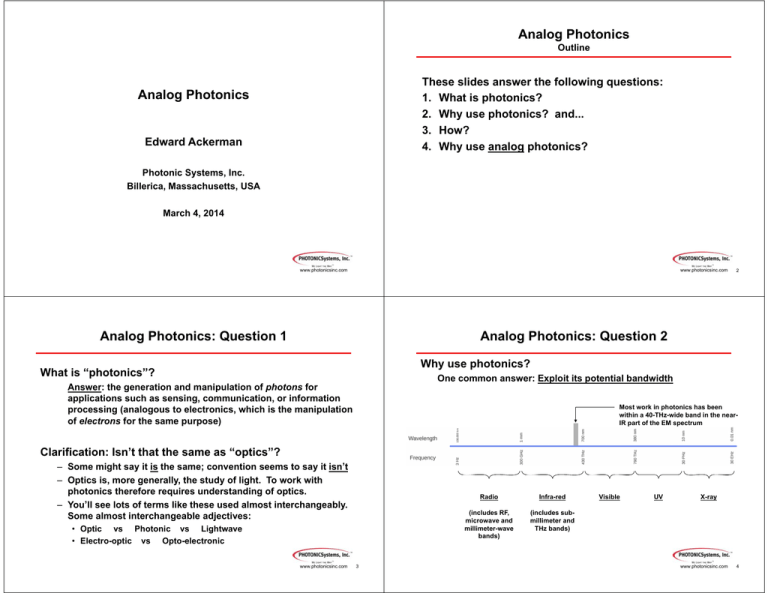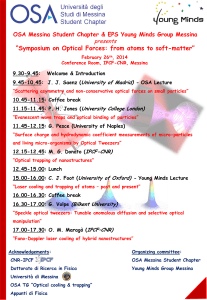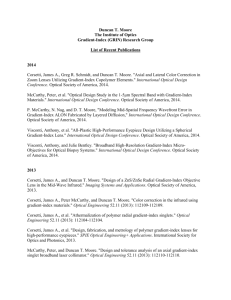Analog
advertisement

Analog Photonics Outline These slides answer the following questions: 1. What is photonics? 2. Why use photonics? and... 3. How? 4. Why use analog photonics? Analog Photonics Edward Ackerman Photonic Systems, Inc. Billerica, Massachusetts, USA March 4, 2014 www.photonicsinc.com www.photonicsinc.com Analog Photonics: Question 1 2 Analog Photonics: Question 2 Why use photonics? What is “photonics”? One common answer: Exploit its potential bandwidth Answer: the generation and manipulation of photons for applications such as sensing, communication, or information processing (analogous to electronics, which is the manipulation of electrons for the same purpose) Most work in photonics has been within a 40-THz-wide band in the nearIR part of the EM spectrum Clarification: Isn’t that the same as “optics”? – Some might say it is the same; convention seems to say it isn’t – Optics is, more generally, the study of light. To work with photonics therefore requires understanding of optics. – You’ll see lots of terms like these used almost interchangeably. Some almost interchangeable adjectives: • Optic vs Photonic vs Lightwave • Electro-optic vs Opto-electronic www.photonicsinc.com 3 Radio Infra-red (includes RF, microwave and millimeter-wave bands) (includes submillimeter and THz bands) Visible UV X-ray www.photonicsinc.com 4 Typical Attenuation for Silica-Based Optical Fiber Analog Photonics: Question 2, cont’d Why use photonics? Infrared absorption tail from lattice transitions 5 –OH absorption peaks 2 Fiber Attenuation (dB in 100 m) Attenuation (dB in 100 m) in Coaxial Cables A second answer: Preserve signal quality over long distances (especially in optical fiber) Compare these data to attenuation in optical fiber (next slide) 1 0.5 0.2 0.1 “Dry” fiber 0.05 Rayleigh Scattering 0.02 0.01 “Near” infrared 0.005 0.002 600 800 1,000 1,200 1,400 1,600 1,800 2,000 Wavelength (nm) 400 http://www.procom.dk/procomlab/product-help/attenuation-versus-frequency Frequency (MHz) www.photonicsinc.com 5 300 Frequency (THz) 200 Source: C. Cox, Analog Optical Links, Cambridge University Press, 2004. 150 www.photonicsinc.com 6 Optical Fibers Analog Photonics: Question 2, cont’d Why use photonics? A third answer: Enable small size and weight (in optical fibers or integrated optical waveguides) 250 feet of typical coax vs optical fiber 125 m Single-mode optical fiber www.photonicsinc.com 7 Fiber spool Multi-mode optical fiber Polarization-maintaining optical fiber Source: C. Cox, Analog Optical Links, Cambridge University Press, 2004. www.photonicsinc.com 8 Analog Photonics: Question 3 A Conventional Electronic Link Baseband or intermediate frequency (IF) signal How to exploit the advantages of photonics (again: huge BW, long distances, small size/weight)? Baseband or intermediate frequency (IF) signal f a. Start with the basic photonic building block: a signal “link” fRF b. Know the devices that are required, and Electronic Mixer Local Oscillator (LO) f Electronic propagation medium c. Understand what link architectures can be used fRF f Electronic Mixer f fRF Local Oscillator (LO) f Conventional Electronic Link www.photonicsinc.com A Photonic Link Amplification in a Link and required devices (at minimum) Electronic (e.g. coaxial-cable) vs Photonic (e.g. fiber-optic) Baseband or intermediate frequency (IF) signal Baseband or intermediate frequency (IF) signal f fRF Local Oscillator (LO) fRF f fRF Electronic Mixer www.photonicsinc.com 9 f Electronic Mixer f Electronic propagation medium fRF Coax Coax Low-noise LNA Amplifier (LNA) f Electronic Mixer f Local Oscillator (LO) fRF 10 LO Electronic Mixer Low-noise LNA Amplifier (LNA) LO Coax Link with RF Amplification f Optical Fiber Optical Fiber fopt Optical Source Optical Source Photonic propagation medium Modulator Modulator Erbium-Doped EDFA Fiber Amplifier (EDFA) EDFA Erbium-Doped Fiber Amplifier (EDFA) Photodetector Photodetector Fiber-optic Link with Optical Amplification fopt Photonic Link www.photonicsinc.com 11 www.photonicsinc.com 12 Channelization in a Link Analog Photonics: Question 3, cont’d Electronic (e.g. coaxial-cable) vs Photonic (e.g. fiber-optic) Signal 1 RF Combiner Signal N Coax Coax LNA LO at fRF N RF Splitter LO at fRF 1 Signal 1 Filter at fRF 1 How to exploit the advantages of photonics (again: huge BW, long distances, small size/weight)? LO at fRF 1 a. Start with the basic photonic building block: a signal “link” Signal N b. Know what devices are required. At minimum: Filter at fRF N a. Optical source LO at fRF N b. Modulator Coax Link with RF Channelization c. Photodetector Signal 1 Optical Source at fopt 1 Signal 1 Optical Fiber Optical Fiber c. Understand what link architectures can be used Photodetector Signal N Signal N Optical Source at fopt N EDFA N-channel N-channel Wavelength-Division WDMs Multiplexers (WDMs) Photodetector Fiber-Optic Link with Optical Channelization www.photonicsinc.com www.photonicsinc.com 13 Photodetector 14 Direct vs Coherent Detection of Light Intensity p-i-n Photodiode Optical illumination = Aopt e j opt t opt “Direct” Detection Input Signal Optical Source Intensity Modulator Output Signal Photodetector j t The quantity Aopt e opt opt is modulated by the input signal “Coherent” Detection Input Signal Optical Source 1 Amplitude, Phase, Frequency, or Intensity Modulator Photodetector j opt 1t opt 1 Either Aopt1 , opt1 , opt1 or Aopt1e is modulated by the input signal Photogenerated current power of incident optical illumination Aopt e http://www.allaboutcircuits.com/vol_3/chpt_3/12.html j opt t opt 2 www.photonicsinc.com 15 Optical Source 2 Output Signal Therefore, the total quantity Aopt1e j opt 1t opt 1 Aopt 2 e j opt 2t opt 2 is modulated by the input signal www.photonicsinc.com 16 Analog Photonic Link Analog Photonics: Question 3, cont’d Direct Modulation How to exploit the advantages of photonics (again: huge BW, long distances, small size/weight)? RF Input Direct Modulation Photonic Link RF Output a. Start with the basic photonic building block: a signal “link” b. Know what devices are required. At minimum: a. Optical source In direct modulation links, one device is both the optical source and modulator b. Modulator c. Photodetector DC DC c. Understand what link architectures can be used RF Output RF Input Diode LASER or LED www.photonicsinc.com www.photonicsinc.com 17 + RFIn FABRY-PEROT DIODE LASER DISTRIBUTED-FEEDBACK DIODE LASER (DFB) VERTICAL-CAVITY SURFACE-EMITTING LASER (VCSEL) •Simple structure •High power available •Major application: CD players •Cost: $10 - 500 •Low laser noise •High linearity •Major application: CATV distribution •Cost: $500 – 5,000 •Testable at wafer level •Circular, low-divergence beam •Major application: LAN links •Cost: $10 -500 OPTICAL SPECTRUM OPTICAL SPECTRUM ID IL 18 Diode Lasers Direct-Modulation / Direct-Detection Link + Photodetector Optical Propagation Medium (e.g., optical fiber) RFOut P0 PD Photodiode ID (mA) PD (mW) Diode Laser SD (A/W) SL (W/A) PD (A/W) IL (mA) g Current gain (loss ) Link gain (loss ) dPD dI D SL SD dI L dPD OPTICAL SPECTRUM Output RF Signal Power 10 log g 2 Input RF Signal Power Source: C. Cox, “Optical transmitters,” in The Electronics Handbook, J. Whitaker, ed., CRC Press, 1996. www.photonicsinc.com 19 www.photonicsinc.com 20 Detector Slope Efficiency vs Bandwidth FP – < 1100 nm FP – ~1300 nm FP – ~1550 nm DFB – < 1100 nm DFB – ~1300 nm DFB – ~1550 nm VCSEL – < 1100 nm VCSEL – ~1300 nm VCSEL – ~1550 nm 1 Theoretical Maximum = h c / q = 0.802 W/A Gray line indicates maximum available at any given frequency DERA ‘98 Bell Labs ‘91 Avalon ‘01 Alcatel ‘04 Chalmers ‘02 Chalmers ‘04 Tokyo Inst. Tech. ‘95 U. Wurtzburg/ Thales/Technion ‘05 0.1 0 U. Michigan/ Bellcore ‘03 Samsung ‘02 Chalmers ‘03 UCSB ‘98 Sandia ‘96 Agilent ‘02 U. Ulm ’94, ‘96 Research Devices Ortel ‘95 Sandia ‘97 Equivalent Device Slope Efficiency SD at 1550 nm (A/W) Equivalent Device Slope Efficiency SL at = 1550 nm (W/A) Directly-Modulated Semiconductor Laser Slope Efficiency vs Bandwidth (Research Devices – not fiber coupled) U. Michigan/Bellcore ‘97 GTE ‘85 UCSB ‘91 Ortel ‘04 National Chiao-Tung U. ‘03 UCSB ‘93 Bell Labs ‘89 U. Cincinnati/Agere /03 Thales ‘04 Rockwell ‘92 U. Wurtzburg ‘04 Bell Labs ‘92 U. Michigan/ Fraunhofer Inst. ‘94 Bellcore ‘97 Bell Labs ‘94 UCSB ‘93 Fraunhofer Inst. ‘06 Hanyang U. ‘04 Cornell U. ‘91 Technische Universitat Berlin/Politecnico di Torino ‘04 U. Michigan/Georgia Tech. ‘98 OKI ‘97 Fraunhofer Inst. ‘94 UCSB ‘97 U. Of Munich, UCB ‘09 10 20 30 40 1.25 1 0.75 0.5 0.25 0 Waveguide (830 nm) PIN – ~1300 nm UMR ‘97 Technische Universitat Berlin ‘96 Waveguide (1000 nm) Navy ‘04 PIN – ~1550 nm Technische Universitat Waveguide (1300 nm) UCSB ‘05 Waveguide (1550 Berlin ‘99 Waveguide PIN – <nm) 1100 nm Thomson ’96, ‘97 ETRI (Korea), 2010 MSM/Schottky (600 nm) Bell Labs Waveguide PIN – ~1300 nm National Taiwan U. ‘05 ‘86 NTT ‘00 NEC ‘99 NTT ‘03 Waveguide PIN – ~1550 nm Fujitsu ‘91 TI ‘97 Epitaxx ‘87 Ortel ‘96 NTT ’91, ‘92 MSM/Schottky – < 1100 nm UVA ‘09 Bilkent U./Boston U. ‘02 UMR ‘97 MSM/Schottky – ~1550 nm GTE ‘85 NTT ‘02 Alcatel ‘04 Bell Labs ‘86 Navy ‘04 UVA ’06 Alcatel ‘00 Boston U./NIST ‘98 Army/Drexel ‘96 UVA ’08 UIUC ‘02 NTT ‘94 Technische Universitat Berlin ‘04 Infineon/IBM ‘04 UCSD ‘93 NTT ‘97 UCLA ‘98 U Texas/Navy ‘03 UCSB/Colorado State ‘95 BT Labs ‘91 UCSB ‘96 National Taiwan/ Raytheon/DSC ‘01 Gray line indicates maximum Bell Labs ‘85 UCSB ‘93 UIUC ‘04 UCLA ‘98 Navy ‘02 available at any given frequency Stanford ‘91 UMR ‘97 UVA ‘06 NTT ‘05 TRW/UCSD ‘99 UCSD ‘03 UCLA/Bell Labs ‘00 NTT ‘03 UMR ‘97 Bell Labs ‘86 U. Michigan/MIT ‘91 Heinrich Hertz/UVA, ‘08 UCSD ‘92 Gerhard Mercator ‘98 UCLA/JPL/Bell Labs ‘96 UCSB ‘95 NTT ‘97 NTT ‘98 UCSB ‘98 Technische Universitat Berlin ‘98 UCSB ‘95 NTT ‘00 10 50 www.photonicsinc.com Experimental Broadband Direct Modulation Link Gain Results > –20 dB 30 Link Gain (dB) 20 10 0 –20 0.01 UCSB, 2003 UCB, 2004 MITLL, 1990 UCLA, 2004 Chalmers U., 2002 0.1 1 Frequency (GHz) 10 www.photonicsinc.com 21 C. Cox, et al., IEEE Trans. Microwave Theory Tech., vol. 54, February 2006. Source: C. Cox, et al., IEEE Trans. Microwave Theory Tech., vol. 54, February 2006. Sun, 1997 100 1000 3 dB Bandwidth (GHz) 3 dB Bandwidth (GHz) –10 PIN –< 1100 nm PIN (1500 nm) Theoretical Maximum = q / h c = 1.249 A/W 23 Source: C. Cox, et al., IEEE Trans. Microwave Theory Tech., vol. 54, February 2006. www.photonicsinc.com 22 Analog Photonics: Question 3, cont’d How to exploit the advantages of photonics (again: huge BW, long distances, small size/weight)? a. Start with the basic photonic building block: a signal “link” b. Know what devices are required. At minimum: a. Optical source b. Modulator In external modulation links, separate devices are the optical source and modulator c. Photodetector c. Understand what link architectures can be used www.photonicsinc.com 24 Analog Photonic Link Single-mode Dielectric Optical Waveguides External Modulation Typical Properties at 1550 nm Fiber RF Input Lithium Niobate RF Output External Modulation Photonic Link Polymer DC Photodetector Modulator RF Input Optical Propagation Medium (e.g., optical fiber) RF Output III-V Semiconductor DC Laser www.photonicsinc.com 25 Figures provided by G. Betts, MIT Lincoln Laboratory V LiNbO3 or Polymer Mach-Zehnder Electro-Optic Modulator V Semiconductor Mach-Zehnder Electro-Optic Modulator V Electroabsorption (in semiconductor) V V Directional Coupler Total Internal Reflection Figures provided by G. Betts, MIT Lincoln Laboratory Semiconductor ElectroAbsorption Modulator V V RFIn RFIn RFIn Laser Laser Laser PI V 26 Transfer Functions of Optical Modulators Examples of Modulator Designs Mach-Zehnder Interferometric Modulator (MZ) www.photonicsinc.com PO PI PO PO PI PI LI PO PI PO PO PI LI LI Mode evolution V www.photonicsinc.com 27 V V www.photonicsinc.com 28 Fujitsu ‘02 NTT ‘91 EA – ~1300 nm EA – ~1550 nm Polymer MZ – ~1300 nm Polymer MZ – ~1550 nm LiNbO3 MZ – < 1100 nm LiNbO3 MZ – ~1300 nm LiNbO3 MZ – ~1550 nm Semicond. MZ – ~1550 1 Kotura ‘09 NEC ‘96 PSI ‘07 France Telecom ‘93 CRL ‘94 Lumera ‘08 OKI ‘97 PSI ‘07 Fujitsu ‘06 OKI ‘97 OKI ’97 NTT ‘07 NGK ‘02 CRL ‘96 Navy/TRW ‘98 NEC ‘92 UCSD/Mitsubishi ‘96 UCLA/USC ‘01 UCSD ‘04 NTT ‘98 NTT ‘91 NG ‘07 Navy ‘00 NTT ‘94 Navy ‘98 HP ‘92 Hughes ‘83 Intel ‘04 Amphenol ‘87 UCSD/Navy ‘01 U. Paris-Sud, ‘08 MITLL ‘96 U. Delaware ‘07 UCSD/Navy ‘94 MITLL ‘96 UCSD’97 GigOptix ‘10 GigOptix ‘09 France Telecom ‘91 HP ‘84 T-Networks ‘02 Navy ‘84 Navy ‘98 UCLA/USC ‘00 MIT ‘85 0.1 0.1 1 10 100 3 dB Bandwidth (GHz) * with optical input power = 400 mW and electrode impedance = 50 (if not reported in literature) www.photonicsinc.com ID V RFIn RFOut P0 CW Laser PD PI Mach-Zehnder Modulator Photodiode SD (A/W) SM(W/A) V V g Current gain (loss ) Link gain (loss ) 29 PD (A/W) dPD dI D P SM SD I SD dV dPD V Output RF Signal Power 10 log g 2 Input RF Signal Power www.photonicsinc.com Amplifierless IM / DD Link Gains > – 20 dB Link Gain vs Detector Current (Input and Output at Same Frequency) 30 40 Gain Predicted By Model Externally Modulated Solid State Laser* 20 10 PSI, 2007 20 Measured Gain Link Gain (dB) Link (dB) LINKRF RF Gain GAIN (dB) 30 Directly Modulated HighSlope-Efficiency Laser 0 -10 Directly Modulated LowSlope-Efficiency Laser -20 PSI, 2007 PSI, 2007 Navy, 1999 10 Johns Hopkins, 2010 Navy, 1997 Navy, 2007 PSI, 2005 MITLL, 1990 L-3, 2007 UCSD, 2004 MITLL, 1990 0 -30 Navy, 2009 -40 0.001 *V = 0.65 V, = 90° 0.01 0.1 1 10 –10 UMass/Drexel U, 2009 100 Navy, 1995 AVERAGE DETECTOR CURRENT (mA) Average Detector Current (mA) –20 0.01 Source: C. Cox, Analog Optical Links, Cambridge University Press, 2004. www.photonicsinc.com 31 UCSD 2004 0.1 1 Frequency (GHz) 30 C. Cox, et al., IEEE Trans. Microwave Theory Tech., vol. 54, February 2006. Avanex ‘07 Navy ‘98 + + ID (mA) 10 External-Modulation / Direct-Detection Link PD /PI Gray line indicates maximum available at any given frequency MITLL ‘96 C. Cox, et al., IEEE Trans. Microwave Theory Tech., vol. 54, February 2006. Equivalent Device Slope Efficiency SM at = 1550 nm* (W/A) Electro-Optic Modulator Slope Efficiency * vs Bandwidth (Research Devices) L-3, 2008 T-Networks, 2004 Navy, 1997 10 www.photonicsinc.com 32 EIA 7030832 (Input and Output at Same Frequency) Direct Modulation External Modulation 30 PSI, 2007 Link Gain (dB) 20 PSI, 2007 PSI, 2007 Navy, 1999 10 Johns Hopkins, 2010 Navy, 1997 Navy, 2007 PSI, 2005 MITLL, 1990 MITLL, 1990 0 UCSD, 2004 –10 UMass/Drexel U, 2009 L-3, 2007 UCSB, 2003 UCB, 2004 Navy, 2009 MITLL, 1990 Navy, 1997 Chalmers U., 2002 Navy, 1995 UCLA, 2004 U Leeds, 2006 –20 0.01 Where Does the Link Gain Come From ? DC DC RF In Laser Modulator Photodetector RF Out Small Signal Efficiency >1 Total Efficiency < 1 L-3, 2008 T-Networks, 2004 Navy, 1997 UCSD 2004 0.1 C. Cox, et al., IEEE Trans. Microwave Theory Tech., vol. 54, February 2006. Amplifierless IM / DD Link Gains > – 20 dB 1 10 Frequency (GHz) www.photonicsinc.com www.photonicsinc.com 33 Analog Photonics: Question 3, cont’d 34 Outline How to exploit the advantages of photonics (again: huge BW, long distances, small size/weight)? These slides answer the following questions: 1. What is photonics? 2. Why use photonics? and... 3. How? 4. Why use analog photonics? a. Start with the basic photonic building block: a signal “link” b. Know what devices are required. At minimum: a. Optical source b. Modulator One common answer: in some antenna remoting situations, A/D conversion at the antenna site is impossible or undesirable c. Photodetector c. Understand what link architectures can be used www.photonicsinc.com 35 www.photonicsinc.com 36 Photonic Remote Sensing Digital vs Analog Links SETI’s Allen Telescope Array Hat Creek, California LO A/D Analog Signals Digital Data Preselector Filter E/O Transducer Optical Fiber O/E Transducer Digital Photonic Link To Signal Digital Processor Data • Downconverter and A/D size and power consumption are major concerns; one set of this hardware is required at each element • Requires phase synchronization of LOs at all the sensor elements LO Analog Signals E/O Transducer Preselector Filter Optical Fiber O/E Transducer Analog Photonic Link A/D Analog Signals Digital Data To Signal Processor • Minimizes size and power consumption of componentry at sensor element; in a phased array, analog signals can be combined and then processed by a single set of down-converter and A/D hardware www.photonicsinc.com www.photonicsinc.com 37 38 Phased Array Antennas Outline Analog Architectures Conventional All-Electronic Implementation These slides answer the following questions: 1. What is photonics? 2. Why use photonics? and... 3. How? 4. Why use analog photonics? Antenna Elements T/R Modules (Element-level Beamforming: Shifters, Splitter/Combiners) Subarraylevel RF beamformer RF-IF Conversion Analog-toDigital Conversion Processing and Display One common answer: in some antenna remoting situations, A/D conversion at the antenna site is impossible or undesirable A second answer: to perform higher processing functions in the optical domain Phased array antenna beamforming RF-IF down-conversion and IF-RF up-conversion A/D conversion www.photonicsinc.com 39 www.photonicsinc.com 40 Phased Array Antennas Straightforward Optical Approach to True Time Delay (TTD) Analog Architectures Conventional Implementation w/Fiber-Optics Benefits: 1. Antenna Elements 2. Photonic T/R Modules Remoting of beamforming and other functions May enable other functions to be performed in optical domain T2 Tn • Conceptually straightforward, historically always limited by switch loss – Lowest switch “on” insertion loss: ~2.5 dB – Consequently total RF-to-RF loss for 8-bit delay: 40 dB Optical Fibers Photonic T/R Modules T1 Subarraylevel RF beamformer RF-IF Conversion Analog-toDigital Conversion Processing and Display www.photonicsinc.com – Electronic switch, wavelength tunable, fiber-optic prism, etc. www.photonicsinc.com 41 Conformal Wide Band Array Controlled by Photonics • • • • • Implication: To date most fiber-optic TTD work has focused on ways to avoid the optical switch 42 Wideband Photonic Beamforming Techniques Fiber-optic realization of a Rotman lens Conformal L-Band array 500 MHz bandwidth, ±60° scan 96 elements, 24 columns, 8 subarrays Each subarray controlled by a 5-bit photonic time shifter from R. Sparks, et al., “Eight beam prototype fiber optic Rotman lens,” Proc. IEEE Top. Meeting on Microwave Photonics, November 1999. Courtesy of J.J.Lee, Raytheon www.photonicsinc.com www.photonicsinc.com 43 EIA 7030843 www.photonicsinc.com 44 Wideband Photonic Beamforming Techniques Photonic Down-Converter Delay determined by fiber dispersion and tunable laser Principle of Operation Spectrum below 100 GHz: LO RF Optical Source IF Optical Filter Modulator Photodetector IF Modulator If photodetector is low-speed, you don’t need the optical filter! Optical Spectrum: from R. Esman, et al., “Microwave true time-delay modulator using fibre-optic dispersion,” Electron. Lett., vol. 28, pp. 1905, September 1992. www.photonicsinc.com 45 Example of Photonic A/D Converter Analog RF V(t) www.photonicsinc.com 46 Summary • We differentiated analog photonics from related fields, such as optics or digital photonics • We examined the basic building block of analog photonics – i.e., the signal link Comparator Parallel Digital Word Pulsed Laser * From datasheet for STMicroelectronics STW82100B RF downconverter (1.6 – 2.4 GHz) ** Projected using PSI’s well-established link performance models – Components: optical source, modulator, photodetector – Candidate architectures: direct modulation, external modulation • We explored some other things that can be done with analog photonics Sampler Quantizer Optics – Phased array beamforming – Up-/Down-conversion – A/D conversion Hold Electronics www.photonicsinc.com 47 www.photonicsinc.com 48


